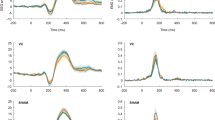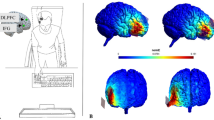Abstract
Stopping outright (reactive inhibition) and slowing down (proactive inhibition) are types of response inhibition which have mainly been investigated in the manual effector system. This study compared reactive inhibition across manual and vocal effector systems, examined the effects of excitatory anodal transcranial direct current stimulation (anodal tDCS) over the right prefrontal cortex (right-PFC) and looked at the relationship between reactive and proactive inhibition. We hypothesised (1) that vocal reactive inhibition would be less effective than manual reactive inhibition as evidenced by longer stop signal reaction times; (2) that anodal tDCS would enhance both vocal and manual reactive inhibitions and (3) that proactive and reactive inhibitions would be positively related. We tested 14 participants over two sessions (one session with anodal tDCS and one session with sham stimulation) and applied stimulation protocol in the middle of the session, i.e. only during the second of three phases. We used a stop signal task across two stop conditions: relevant and irrelevant stop conditions in which stopping was required or ignored, respectively. We found that reactive inhibition was faster during and immediately after anodal tDCS relative to sham. We also found that greater level of proactive inhibition enhanced reactive inhibition (indexed by shorter stop signal reaction times). These results support the hypothesis that the right-PFC is part of a core network for reactive inhibition and supports previous contention that proactive inhibition is possibly modulated via preactivating the reactive inhibition network.



Similar content being viewed by others
References
Aron AR (2011) From reactive to proactive and selective control: developing a richer model for stopping inappropriate responses. Biol Psychiatr 69(12):e55–e68. doi:10.1016/j.biopsych.2010.07.024
Aron AR, Poldrack RA (2005) The cognitive neuroscience of response inhibition: relevance for genetic research in Attention-Deficit/Hyperactivity Disorder. Biol Psychiatr 57(11):1285–1292. doi:10.1016/j.biopsych.2004.10.026
Aron AR, Fletcher PC, Bullmore ET, Sahakian BJ, Robbins TW (2003) Stop-signal inhibition disrupted by damage to right inferior frontal gyrus in humans. Nat Neurosci 6(2):115–116. doi:10.1038/nn1003
Aron AR, Robbins TW, Poldrack RA (2004) Inhibition and the right inferior frontal cortex. Trends Cogn Sci 8(4):170–177. doi:10.1016/j.tics.2004.02.010
Aron AR, Behrens TE, Smith S, Frank MJ, Poldrack RA (2007) Triangulating a cognitive control network using diffusion-weighted magnetic resonance imaging (MRI) and functional MRI. J Neurosci 27(14):3743–3752. doi:10.1523/jneurosci.0519-07.2007
Barkley RA (1997) Behavioral inhibition, sustained attention, and executive functions: constructing a unifying theory of ADHD. Psychol Bull 121(1):65–94. doi:10.1037/0033-2909.121.1.65
Beeli G, Casutt G, Baumgartner T, Jäncke L (2008) Modulating presence and impulsiveness by external stimulation of the brain. Behav Brain Funct 4:33. doi:10.1186/1744-9081-4-33
Bissett PG, Logan GD (2014) Selective stopping? Maybe not. J Exp Psychol Gen 143(1):455–472. doi:10.1037/a0032122
Bohne A, Savage CR, Deckersbach T, Keuthen NJ, Wilhelm S (2008) Motor inhibition in trichotillomania and obsessive-compulsive disorder. J Psychiatr Res 42(2):141–150. doi:10.1016/j.jpsychires.2006.11.008
Boucher L, Stuphorn V, Logan G, Schall J, Palmeri T (2007) Stopping eye and hand movements: are the processes independent? Percept Psychophys 69(5):785–801. doi:10.3758/BF03193779
Cai W, Oldenkamp CL, Aron AR (2012) Stopping speech suppresses the task-irrelevant hand. Brain Lang 120(3):412–415. doi:10.1016/j.bandl.2011.11.006
Castro-Meneses LJ, Johnson BW, Sowman PF (2015) The effects of impulsivity and proactive inhibition on reactive inhibition and the go process: insights from vocal and manual stop signal tasks. Front Hum Neurosci 9. doi:10.3389/fnhum.2015.00529
Chambers CD, Bellgrove MA, Stokes MG, Henderson TR, Garavan H, Robertson IH, Mattingley JB (2006) Executive “Brake Failure” following deactivation of human frontal lobe. J Cogn Neurosci 18(3):444–455. doi:10.1162/089892906775990606
Chambers CD, Bellgrove MA, Gould IC, English T, Garavan H, McNaught E, Mattingley JB (2007) Dissociable mechanisms of cognitive control in prefrontal and premotor cortex. J Neurophysiol 98(6):3638–3647. doi:10.1152/jn.00685.2007
Chambers CD, Garavan H, Bellgrove MA (2009) Insights into the neural basis of response inhibition from cognitive and clinical neuroscience. Neurosci Biobehav Rev 33(5):631–646. doi:10.1016/j.neubiorev.2008.08.016
Chikazoe J, Jimura K, Hirose S, Yamashita K-I, Miyashita Y, Konishi S (2009) Preparation to inhibit a response complements response inhibition during performance of a stop-signal task. J Neurosci 29(50):15870–15877. doi:10.1523/jneurosci.3645-09.2009
Cruccu G, Inghilleri M, Berardelli A, Romaniello A, Manfredi M (1997) Cortical mechanisms mediating the inhibitory period after magnetic stimulation of the facial motor area. Muscle Nerve 20(4):418–424. doi:10.1002/(SICI)1097-4598(199704)20:4<418:AID-MUS3>3.0.CO;2-D
Curtis CE, Cole MW, Rao VY, D’Esposito M (2005) Canceling planned action: an fMRI study of countermanding saccades. Cereb Cortex 15(9):1281–1289. doi:10.1093/cercor/bhi011
Ditye T, Jacobson L, Walsh V, Lavidor M (2012) Modulating behavioral inhibition by tDCS combined with cognitive training. Exp Brain Res 219(3):363–368. doi:10.1007/s00221-012-3098-4
Eggers K, De Nil LF, Van den Bergh BRH (2013) Inhibitory control in childhood stuttering. J Fluency Disord 38(1):1–13. doi:10.1016/j.jfludis.2012.10.001
Enticott PG, Ogloff JRP, Bradshaw JL (2008) Response inhibition and impulsivity in schizophrenia. Psychiatr Res 157(1):251–254. doi:10.1016/j.psychres.2007.04.007
Etchell AC, Sowman PF, Johnson BW (2012) “Shut up!” An electrophysiological study investigating the neural correlates of vocal inhibition. Neuropsychologia 50(1):129–138. doi:10.1016/j.neuropsychologia.2011.11.009
Filevich E, Kühn S, Haggard P (2012) Negative motor phenomena in cortical stimulation: implications for inhibitory control of human action. Cortex 48(10):1251–1261. doi:10.1016/j.cortex.2012.04.014
Filmer HL, Mattingley JB, Marois R, Dux PE (2013) Disrupting prefrontal cortex prevents performance gains from sensory-motor training. J Neurosci 33(47):18654–18660. doi:10.1523/jneurosci.2019-13.2013
Giglia G, Brighina F, Rizzo S, Puma A, Indovino S, Maccora S, Fierro B (2014) Anodal transcranial direct current stimulation of the right dorsolateral prefrontal cortex enhances memory-guided responses in a visuospatial working memory task. Funct Neurol 29(3):189–193
Glass JM, Williams DA, Fernandez-Sanchez M-L, Kairys A, Barjola P, Heitzeg MM, Schmidt-Wilcke T (2011) Executive function in chronic pain patients and healthy controls: different cortical activation during response inhibition in fibromyalgia. J Pain 12(12):1219–1229. doi:10.1016/j.jpain.2011.06.007
Hsu T-Y, Tseng L-Y, Yu J-X, Kuo W-J, Hung DL, Tzeng OJL, Juan C-H (2011) Modulating inhibitory control with direct current stimulation of the superior medial frontal cortex. NeuroImage 56(4):2249–2257. doi:10.1016/j.neuroimage.2011.03.059
Jaberzadeh S, Sakuma S, Zoghi M, Miles TS, Nordstrom MA (2008) Focal transcranial magnetic stimulation of motor cortex evokes bilateral and symmetrical silent periods in human masseter muscles. Clin Neurophysiol 119(3):693–703. doi:10.1016/j.clinph.2007.11.005
Jacobson L, Javitt DC, Lavidor M (2011) Activation of inhibition: diminishing impulsive behavior by direct current stimulation over the inferior frontal gyrus. J Cogn Neurosci 23(11):3380–3387. doi:10.1162/jocn_a_00020
Jaffard M, Longcamp M, Velay J-L, Anton J-L, Roth M, Nazarian B, Boulinguez P (2008) Proactive inhibitory control of movement assessed by event-related fMRI. NeuroImage 42(3):1196–1206. doi:10.1016/j.neuroimage.2008.05.041
Jahfari S, Stinear CM, Claffey M, Verbruggen F, Aron AR (2010) Responding with restraint: what are the neurocognitive mechanisms? J Cogn Neurosci 22(7):1479–1492. doi:10.1162/jocn.2009.21307
Jasper HH (1958) The ten-twenty electrode system of the International Federation. Electroencephalogr Clin Neurophysiol 10:371–375
Jongsma ML, Postma SA, Souren P, Arns M, Gordon E, Vissers K, van Goor H (2011) Neurodegenerative properties of chronic pain: cognitive decline in patients with chronic pancreatitis. PLoS ONE. doi:10.1371/journal.pone.0023363
Juan C-H, Muggleton NG (2012) Brain stimulation and inhibitory control. Brain Stimul 5(2):63–69. doi:10.1016/j.brs.2012.03.012
Kiehl KA, Smith AM, Hare RD, Liddle PF (2000) An event-related potential investigation of response inhibition in schizophrenia and psychopathy. Biol Psychiatr 48(3):210–221. doi:10.1016/S0006-3223(00)00834-9
Logan GD (1994) On the ability to inhibit thought and action: a users’ guide to the stop signal paradigm. In: Dagenbach D, Carr TH (eds) Inhibitory processes in attention, memory, and language. Academic Press, San Diego, pp 189–239
Logan GD, Cowan WB (1984) On the ability to inhibit thought and action: a theory of an act of control. Psychol Rev 91(3):295–327. doi:10.1037/0033-295x.91.3.295
Logan GD, Irwin DE (2000) Don’t look! Don’t touch! Inhibitory control of eye and hand movements. Psychon Bull Rev 7(1):107–112. doi:10.3758/BF03210728
Logan GD, Schachar RJ, Tannock R (1997) Impulsivity and inhibitory control. Psychol Sci 8(1):60–64. doi:10.1111/j.1467-9280.1997.tb00545.x
Luschei ES, Goldberg LJ (2011) Neural mechanisms of mandibular control: Mastication and voluntary biting. Compr Physiol. John Wiley & Sons, Inc
Menzies L, Achard S, Chamberlain SR, Fineberg N, Chen CH, del Campo N, Bullmore E (2007) Neurocognitive endophenotypes of obsessive-compulsive disorder. Brain 130(Pt 12):3223–3236. doi:10.1093/brain/awm205
Ortu E, Deriu F, Suppa A, Giaconi E, Tolu E, Rothwell JC (2008) Intracortical modulation of cortical-bulbar responses for the masseter muscle. J Physiol 586(14):3385–3404. doi:10.1113/jphysiol.2008.153288
Osman A, Kornblum S, Meyer DE (1986) The point of no return in choice reaction time: controlled and ballistic stages of response preparation. J Exp Psychol Hum Percep Perform 12(3):243–258. doi:10.1037/0096-1523.12.3.243
Osman A, Kornblum S, Meyer DE (1990) Does motor programming necessitate response execution? J Exp Psychol Hum Percep Perform 16(1):183–198. doi:10.1037/0096-1523.16.1.183
Paradiso GO, Cunic DI, Gunraj CA, Chen R (2005) Representation of facial muscles in human motor cortex. J Physiol 567(1):323–336. doi:10.1113/jphysiol.2005.088542
Penadés R, Catalán R, Rubia K, Andrés S, Salamero M, Gastó C (2007) Impaired response inhibition in obsessive compulsive disorder. Eur Psychiar 22(6):404–410. doi:10.1016/j.eurpsy.2006.05.001
Rubia K, Russell T, Overmeyer S, Brammer MJ, Bullmore ET, Sharma T, Taylor E (2001) Mapping motor inhibition: conjunctive brain activations across different versions of Go/No-Go and stop tasks. NeuroImage 13(2):250–261. doi:10.1006/nimg.2000.0685
Rubia K, Smith AB, Brammer MJ, Taylor E (2003) Right inferior prefrontal cortex mediates response inhibition while mesial prefrontal cortex is responsible for error detection. NeuroImage 20(1):351–358. doi:10.1016/S1053-8119(03)00275-1
Sandler AD (2003) Tics and problem behaviors in schoolchildren: prevalence, characterization, and associations. J Dev Behav Pediatr 24(1):84
Sowman PF, Flavel SC, McShane CL, Miles TS, Nordstrom MA (2008) Transcranial magnetic stimulation reduces masseter motoneuron pool excitability throughout the cortical silent period. Clin Neurophysiol 119(5):1119–1129. doi:10.1016/j.clinph.2007.12.019
Stinear CM, Coxon JP, Byblow WD (2009) Primary motor cortex and movement prevention: where Stop meets Go. Neurosci Behav Rev 33(5):662–673. doi:10.1016/j.neubiorev.2008.08.013
van den Wildenberg WPM, Christoffels IK (2010) STOP TALKING! Inhibition of speech is affected by word frequency and dysfunctional impulsivity. Front Psychol 1:145. doi:10.3389/fpsyg.2010.00145
Veldhuijzen DS, Sondaal SF, Oosterman JM (2012) Intact cognitive inhibition in patients with fibromyalgia but evidence of declined processing speed. J Pain 13(5):507–515. doi:10.1016/j.jpain.2012.02.011
Verbruggen F, Logan GD (2008) Response inhibition in the stop-signal paradigm. Trends Cogn Sci 12(11):418–424. doi:10.1016/j.tics.2008.07.005
Verbruggen F, Logan GD (2009) Models of response inhibition in the stop-signal and stop-change paradigms. Neurosci Biobehav Rev 33(5):647–661. doi:10.1016/j.neubiorev.2008.08.014
Verbruggen F, Aron AR, Stevens MA, Chambers CD (2010) Theta burst stimulation dissociates attention and action updating in human inferior frontal cortex. Proc Natl Acad Sci USA 107(31):13966–13971. doi:10.1073/pnas.1001957107
Verbruggen F, Chambers CD, Logan GD (2013) Fictitious inhibitory differences: how skewness and slowing distort the estimation of stopping latencies. Psychol Sci 24(3):352–362. doi:10.1177/0956797612457390
Werhahn KJ, Classen J, Benecke R (1995) The silent period induced by transcranial magnetic stimulation in muscles supplied by cranial nerves: normal data and changes in patients. J Neurol Neurosurg Psychiatry 59(6):586–596. doi:10.1136/jnnp.59.6.586
Wessel JR, Aron AR (2014) It’s not too late: the onset of the frontocentral P3 indexes successful response inhibition in the stop-signal paradigm. Psychophysiol. doi:10.1111/psyp.12374
Xue G, Aron AR, Poldrack RA (2008) Common neural substrates for inhibition of spoken and manual responses. Cereb Cortex 18(8):1923–1932. doi:10.1093/cercor/bhm220
Ziemann U, Paulus W, Rothenberger A (1997) Decreased motor inhibition in Tourette’s disorder: evidence from transcranial magnetic stimulation. Am J Psychiatr 154(9):1277–1284. doi:10.1176/ajp.154.9.1277
Funding
This research was supported by Macquarie University Research Excellence Scholarships (MQRES), National Health and Medical Research Council, Australia (#1003760), and the Australian Research Council (DE130100868).
Author contributions
LCM and PFS designed the experiments, collected and analysed the data. LCM, PFS and BWJ wrote the manuscript.
Author information
Authors and Affiliations
Corresponding author
Ethics declarations
Conflict of interest
The authors declare that they have no conflict of interest.
Additional information
Leidy J Castro-Meneses and Paul F. Sowman have contributed equally to this work.
Appendices
Appendix 1
See Table 1.
Appendix 2
See Table 2.
Appendix 3
Analyses of Spearman correlations between proactive and reactive inhibition.
See Table 3.
Appendix 4
Results for the 2 × 3 × 2 repeated-measures ANOVA for proactive inhibition. This ANOVA was done for the effects of two sessions (session with anodal tDCS and session with sham), three phases (phase-1, phase-2 and phase-3) and two response modalities (manual and vocal). The results showed that session had no effect on proactive inhibition.
See Table 4.
Rights and permissions
About this article
Cite this article
Castro-Meneses, L.J., Johnson, B.W. & Sowman, P.F. Vocal response inhibition is enhanced by anodal tDCS over the right prefrontal cortex. Exp Brain Res 234, 185–195 (2016). https://doi.org/10.1007/s00221-015-4452-0
Received:
Accepted:
Published:
Issue Date:
DOI: https://doi.org/10.1007/s00221-015-4452-0




